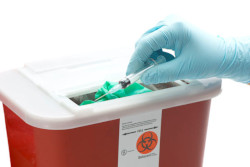Methods to Control the Risk of Exposure
The recommended infection-control concept called "Universal Precautions" advocates everyone's blood and body fluids be considered potentially infectious. This eliminates the difficulty in determining risk individually. Remember, although some bodily fluids have not been documented to transmit pathogens, it is sometimes impossible to tell if blood or another potentially infectious fluid is present.
The two essential control strategies employees use to eliminate or minimize the transmission of bloodborne diseases in the workplace are engineering controls and work practice controls.
Examples include:
- Engineering controls: A sharps container is a good example of an engineering control.
- Work practice controls: Good personal hygiene and housekeeping are the primary work practice controls.
Prohibited Practices
Practices that are completely prohibited in the workplace include: bending, recapping, and removing contaminated needles, shearing or breaking needles, and mouth pipetting or suctioning of potentially infectious material. These practices significantly increase the risk of exposure. They should never be performed by employees.
Knowledge Check Choose the best answer for the question.
1-8. Which is an engineering control used to reduce exposure to bloodborne pathogens?
You forgot to answer the question!

